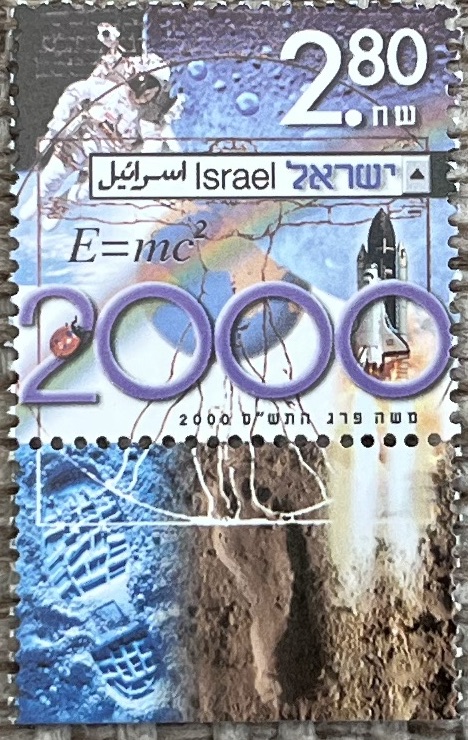
TO INFINITY AND BEYOND

In recent weeks, India excited us all with its third lunar exploration mission, Chandrayaan-3. On 23 August the lunar lander, Vikram, successfully touched down on the moon’s surface near the lunar south pole, carrying a rover vehicle, Pragyan.
While India was the fourth country to have a successful lunar landing program, many smaller countries have carried out, and are carrying out, successful space and satellite programs, and ground-based astronomical observation, enhancing their own national technological achievement. One of these is Israel which coordinates all of its scientific and commercial space research programs through the Israel Space Agency (ISA).
Israel’s space program relies on the impressive base of technologies such as those developed by Israel Aerospace Industries (IAI), Elop (Electro-optics, Elbit Systems), Rafael Advanced Defence Systems, and others, in collaboration with the Ministry of Defence, the ISA, the Ministry of Science and Technology, and Israeli academics.

Space flight had long gripped the popular imagination, not least as expressed in the writing of the French author, Jules Verne (1828-1905) – From the Earth to the Moon (1865). Then in July 1969, the world watched as two Americans became the first humans to walk on the Moon. In biblical mythology too, it seemed that humans connected themselves to the heavens: ‘a chariot of fire appeared with horses of fire […] and Elijah went up by a whirlwind into heaven’ (2 Kings 2).
Designed by Avi Katz, the 5.60 NIS stamp (see above), one in a set of three celebrating ‘Science Fiction: Robotics, Travel in Time, Travel in Space’, issued on 5 December 2000, was illustrated with an outline of Jules Verne, Elijah and the chariot of fire, and the American lunar landing module.

Designed by Asher Kalderon and issued on 6 June 1972, a 1 Israeli Pound stamp (see above) celebrated the Communications Ground Station (satellite relay station) in the Elah Valley (Emek Ha Elah), in the Jerusalem Hills, Israel. The ground station and antenna transmitted international telephone calls (and also telegrams and telex, computer data and television broadcasts) to INTELSTAT Satellite No. 4 which was placed over the Atlantic at an altitude of 36,000 kilometers.

In September 1988, Israel became a successful satellite-launching nation, one of seven at the time, with the launch and orbit of the Ofeq-1 satellite (Horizon). The satellite was placed into orbit by a Shavit three-stage launch rocket, and both had been products of Israel’s advanced commercial R&D space program. The Ofeq-2 satellite was launched in 1989, and Ofeq-3 in 1995. Designed by G. Sagi, a 2.05 NIS stamp (see above), issued on 5 December 1996, celebrated Israeli space research. The stamp showed Ofeq-3, the Shavit rocket, and planet Earth.

One in a set of four stamps, this 2.80 NIS value (see above), designed by M. Pereg, was issued on 1 January 2000 to celebrate ‘Millennium Space Research, Biotechnology, Internet, the Quality of Life’. The 2.80 NIS stamp featured ‘space research’, and was illustrated with a view of the moon’s surface, an astronaut, a space shuttle in the launching stage, and the formula for Einstein’s theory of relativity. On the tab is an image of a footprint on the moon, and a footprint on the earth.

On 28 April 2009 a set of three stamps designed by D. Ben Hador was issued to mark the ‘International Year of Astronomy’. The 3.80 NIS value (see above) and the 8 .50 NIS value (see below) were illustrated with motifs representing gravitational lensing, and the laser interferometer space antenna (LISA), respectively. Gravitational lensing is the phenomenon of light rays changing course due to gravitational force, and the lensing may be created by regular stars or by more dense astronomical bodies such as black holes, galaxies, or clusters of stars. The largest of the ground- and space-based telescopes have photographed images of very, very distant astronomical bodies after they have undergone gravitational lensing.

Gravitational radiation is a field of astronomical research involving the examination of radiation in spectral regions. LISA will detect and measure gravitational waves, and the system comprises 3 spacecraft arranged at the apexes of an equilateral triangle and connected by laser beams. The LISA mission headed by the European Space Agency (ESA) and a collaboration between ESA, NASA, and an international consortium of scientists.
The tab on each of the values of the ‘International Year of Astronomy’ issues, show Galileo Galilei’s telescope.

Ronen Goldberg designed the set of three stamps (see above) issued on 9 February 2021 and honoring ‘Remote-sensing Satellites in Israel (TechSAR)’. Israel has for some years become a leader in the development of remote-sensing satellites and payloads.
Remote-sensing covers a range of methods to detect, identify and track targets, through mechanical, electronic, and optic means – in preservation activities, research and science, use of resources, and for military objectives. Remote-sensing can be performed from space using satellites or satellite payloads.

Designed by D. Ben Hador and issued on 24 August 2021, a set of three stamps each with a value of 4.10 NIS celebrated Israel’s astronomical observatories – at Giv’atayim, at Mitzpe Ramon in the Negev Desert, and at the international dark-sky park near in the Ramon Crater. The stamps offer illustrations of the observatories and their equipment in use.



This month’s post was supported with data from: (1) Israel Philatelic Federation; (2) LISA, at NASA.